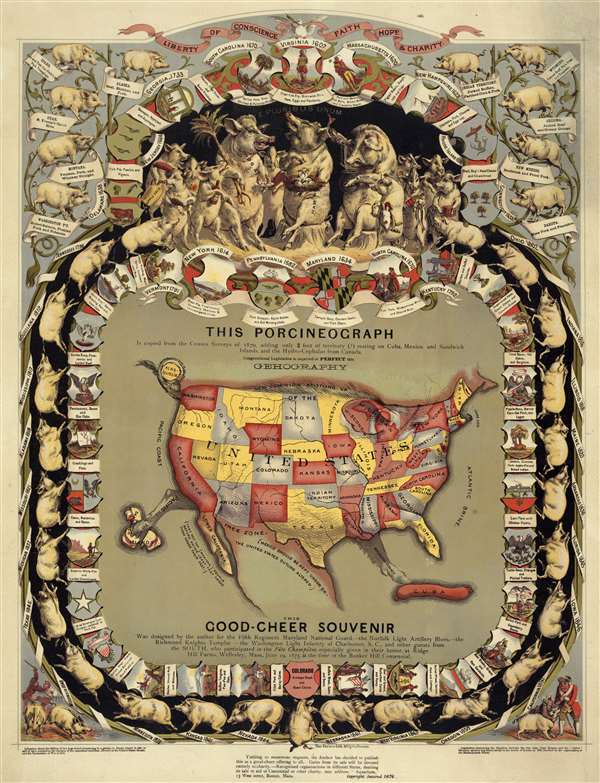This item has been sold, but you can get on the Waitlist to be notified if another example becomes available, or purchase a digital scan.
1876 Baker Pictorial 'Porcineograph' Map of the United States (as Pig)
Porcineograph-baker-1876
Title
1876 (dated) 23 x 17 in (58.42 x 43.18 cm)
Description
This map was produced by William Emerson Baker in 1876.
CartographerS
William Emerson Baker (May, 1828 - January 5, 1888) was a successful American businessman and activist. Baker was born in Roxbury, Massachusetts and as a young man entered into a business partnership with Boston tailor William Grover. Together, the pair created the Grover and Baker Sewing Machine Company, which produced accessibly-priced sewing machines for home use. These units were so successful that Baker retired in 1868, then just forty, already a very rich man. Upon his retirement, Baker bought nearly 800 acres of land in the southwest corner of Needham, Massachusetts. His estate became known by two names - Ridge Hill Farms and the Baker Estate. Over the course of the ensuing twenty years, Baker installed over 100 amusements, attractions, and exhibits on his estate, which included a museum of industry, two bear pits for his pets, a pleasure lake, an underground crystal grotto featuring the Forty Thieves, restaurants, saloons, and a 222-room luxury hotel. At heart, Baker was an activist. Even though his estate appeared on the surface to be simply an amusement park, each attraction served a purpose and the estate became the embodiment of Baker's personal, 'often radical and always provocative', opinions. Baker even opened what he dubbed a 'Sanitary Piggery' on his estate in an effort to convince society that cleanly-produced food and public sanitation could help eliminate disease (a radical notion at the time). The pigs in the 'Sanitary Piggery' were kept in strictly clean conditions and fed wholesome food. There were even rumors that each pig was provided with a bed and silk sheets! After Baker's death in 1888, his wife sold Ridge Hill Farms. There were efforts to keep the attractions up and running, but fires and lack of funds eventually led to their closure. Today, the land is mostly residential lots, leaving few traces of Baker's 'Fairyland of the Beautiful and Bizarre.' More by this mapmaker...
William H. Forbes (1836 - February 3, 1915) was an English-American businessman and printer active in the second half of the 19th and early 20th centuries. Forbes was born in Liverpool England and immigrated to the United States at 12 years old. In the United States, he lived with Quaker relatives at Milton-on-the-Hudson, who provided him with a top-notch education. Forbes apprenticed as lithographer under H. A. Strong in New York. Following his maturity, he relocated to Boston in 1861, founding William H. Forbes and Company shortly after, in 1862. Forbes proved an excellent lithographer and savvy businessman. He reorganized his growing printing concern in 1875, incorporating as Forbes Lithograph Manufacturing Company in 1875. They focused on lithography, embossing, Albertype process printing, typesetting, copper and steel plate printing, and photolithography. At its height, Forbes Lithograph Manufacturing Company had over 70 presses located in Boston, New York, Chicago, and London, and staffed more than 600 workers, including 60 designers, artists, engravers, and lithograph artists. By 1881, Forbes himself had taken a back seat, working as the company treasurer, with William P. Hunt serving as president. In his personal life Forbes was well liked. He married the sister of well-known lithographer Louis Prang. After his death, the firm was taken over by his son, William S. Forbes. During World War II they were major printers of Allied military currency, producing more than 4 billion notes. The firm went out of business in the second half of the 20th century. Learn More...

